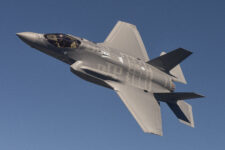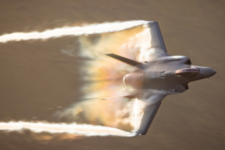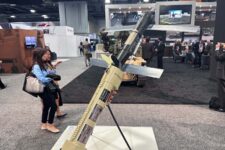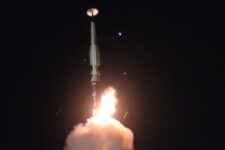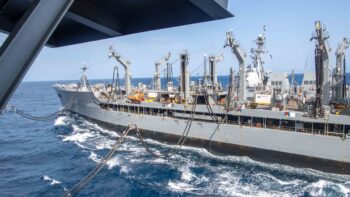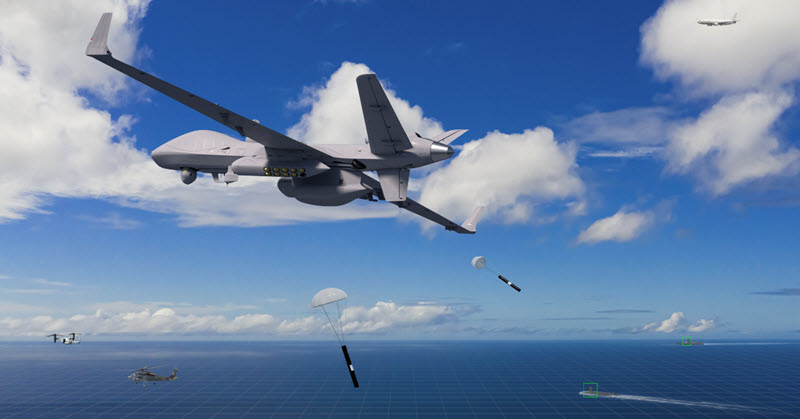
GA-ASI’s MQ-9B SeaGuardian remotely piloted aircraft in its anti-submarine warfare configuration. (Image courtesy of GA-ASI)
World aerospace leaders are gathering for the Singapore Airshow amidst a global security situation so difficult that it heightens fears about how much worse things could get.
The prospect for regional crises to turn into major conflicts with worldwide implications has prompted many nations to step up their plans and preparations to ensure they aren’t taken by surprise.
That’s why intelligence, surveillance, and reconnaissance is so critical, and why defense and security services around the world are turning to the new generation of remotely piloted aircraft systems (RPAS) that serve as the essential brick in the foundation.
Two key examples are the MQ-9B SkyGuardian® and SeaGuardian®, the large medium-high altitude, long-endurance multi-mission aircraft built by San Diego-based General Atomics Aeronautical Systems, Inc. A number of advanced operators are using the platform to rewrite their old practices for multi-domain operations.
The U.S. Navy, for example, has integrated the SeaGuardian into several sophisticated international exercises in the Pacific – using the aircraft to escort surface action groups, serve as a communications relay for warships and aircraft, and establish new concepts of operation against hostile submarines.
SeaGuardian can stay aloft for much longer than a human-crewed aircraft, making it ideal for the long loiter times involved with surface operations or hunting subsurface targets. The aircraft can release sonobuoys – sensors that splash through the ocean surface to search for submarines – and then monitor their signals. Or it can leave that monitoring role to another aircraft or take on the duty of monitoring sonobuoys released by another aircraft, such as a naval helicopter.
Some of the MQ-9B’s incredible versatility comes from the diversity of payloads it can carry. Instead of submarine-hunting equipment or a maritime search radar, an aircraft might carry dedicated equipment for relaying communications or collecting intelligence. Or it might fly with a purpose-built electronic warfare system to degrade a hostile force’s sensing or communications capabilities.
SeaGuardian and SkyGuardian might also carry other smaller uncrewed systems. The larger aircraft are an ideal mothership for smaller ones, such as a GA-ASI system called Sparrowhawk® that MQ-9B can release and later recapture in mid-flight. These kinds of small uncrewed aircraft support operations against hostile air defense systems and can conduct other high-risk missions without imperiling any human aircraft crews.
An MQ-9B might patrol to the edge of international airspace, for instance, and then release a Sparrowhawk for a closer look over a contested island. Upon mission completion, the Sparrowhawk would return, and the larger aircraft would reel it in with GA-ASI’s aerial recovery system.
The U.S. Air Force’s Special Operations Command is using MQ-9B to prove out complex new multi-ship operations involving large, medium-sized and small uncrewed aircraft. Other users around the world also are using these systems to elevate their operations to new levels.
The UK’s Royal Air Force is now taking delivery of its variant called the Protector RG Mk1. The Japan Coast Guard is using MQ-9B to sustain high-quality maritime domain awareness around the Japanese home islands. And the Indian Navy is using SeaGuardian to extend and improve its reach over the Indian Ocean and further abroad.
The need is real. Earlier this year, a cargo ship issued a distress call: it was being boarded by armed men in the Arabian Sea. The Indian Navy’s MQ-9B was among the first assets to respond and it was instrumental in coordinating the fleet response of other aircraft and ships. Indian Navy commanders watched events unfold in real time, in high-definition video, thanks to the SeaGuardian orbiting overhead.
Naval applications for MQ-9B aircraft go beyond search and rescue and counterpiracy. The aircrafts’ long endurance and precise sensing make them ideal platforms for long-range targeting – a SeaGuardian could identify and pursue a surface target for much longer than any other aircraft and without the intermittent loss of contact associated with other downward-looking sensors. If a crisis became a conflict and an allied navy, air, or land force needed to engage a target, it could launch standoff weapons using the precision intelligence provided by the MQ-9B.
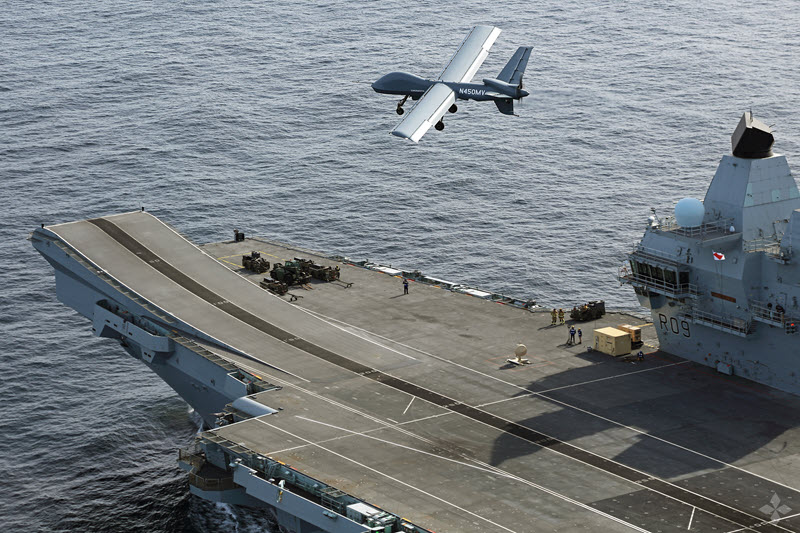
GA-ASI’s Mojave RPAS taking off and landing aboard the HMS Prince of Wales on November 15, 2023. (Image courtesy of GA-ASI)
A future short takeoff and landing variant of the MQ-9B would take all this capability and make it available from aircraft carriers or large-deck amphibious ships. In late 2023, the UK’s Royal Navy and GA-ASI’s Mojave RPAS proved that carriers without catapults and arresting gear can launch and recover turboprop-powered medium-altitude, long-endurance uncrewed aircraft. This historic test aboard the HMS Prince of Wales took place off the East Coast of the United States and earned its place in aviation history when Mojave seamlessly performed the short takeoff and landing.

GA-ASI’s Gray Eagle 25M deploying Eaglet, an SUAS that extends warfighter capability in contested battlespace. (Image courtesy of GA-ASI)
And while the MQ-9B SeaGuardian and SkyGuardian excel in multi-domain employments, another GA-ASI RPAS ready to meet evolving security challenges is the Gray Eagle 25M (GE-25M). GE-25M incorporates open architecture aircraft and ground systems, delivers endurance of over 40 hours, and is equipped with advanced data links and an upgraded propulsion system. Its ability to operate at standoff ranges in threat environments is enhanced through GA-ASI’s new EagleEye radar, improved COMINT and ELINT systems, and the employment of GA-ASI’s Small Unmanned Aircraft System (SUAS), Eaglet. The modernized GE-25M can operate in multi-domain ISREW roles and allows for seamless manned-unmanned teaming with aircraft like the AH-64E Apache helicopter.
New jet aircraft are forthcoming too, including a new air-to-air armed system called LongShot, built under the auspices of the U.S. Defense Advanced Research Projects Agency. This new high-speed RPAS will ride aboard a larger human-crewed aircraft, such as an F-15 EX Eagle II, and launch mid-flight to help provide aerial security for the allied air component, join an offensive element, or provide a barrier combat presence to defend allied ships against aggressors.

GA-ASI’s new generation of UAS, the Gambit Series.
Another major uncrewed air vehicle effort includes the four aircraft in the Gambit Series, which respond to U.S. and allied needs to even the numerical odds against sophisticated adversaries with ever-greater numbers of threat aircraft.
The Gambit aircraft are produced with a common core that eases production and reduces their comparative cost, enabling mass production at the speed needed by the U.S. Air Force and its allies. The series includes a long-endurance version, an unarmed air domain awareness platform, an air-to-air armed interceptor, a high-fidelity trainer for human student pilots, and a low-observable, long-endurance surveillance platform.
These and other unmanned aircraft in development by GA-ASI and its partners will be part of the discussion at the Singapore Airshow. The goal is to ensure that responsible world powers have the tools to keep ahead of security challenges before they deteriorate into crises – and if conflict can’t be prevented, that responsible governments are ready to respond.
